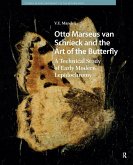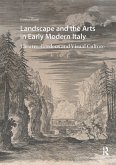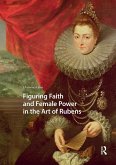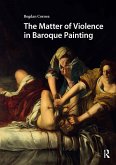V. E. Mandrij
Otto Marseus van Schrieck (c. 1620-1678) and the Lepidochromy Technique (eBook, PDF)
Ornamenting a Painting with a Butterfly
42,95 €
42,95 €
inkl. MwSt.
Erscheint vor. 14.11.25

21 °P sammeln
42,95 €
Als Download kaufen

42,95 €
inkl. MwSt.
Erscheint vor. 14.11.25

21 °P sammeln
Jetzt verschenken
Alle Infos zum eBook verschenken
42,95 €
inkl. MwSt.
Erscheint vor. 14.11.25
Alle Infos zum eBook verschenken

21 °P sammeln
Sollten wir den Preis dieses Artikels vor dem Erscheinungsdatum senken, werden wir dir den Artikel bei der Auslieferung automatisch zum günstigeren Preis berechnen.
V. E. Mandrij
Otto Marseus van Schrieck (c. 1620-1678) and the Lepidochromy Technique (eBook, PDF)
Ornamenting a Painting with a Butterfly
- Format: PDF
- Merkliste
- Auf die Merkliste
- Bewerten Bewerten
- Teilen
- Produkt teilen
- Produkterinnerung
- Produkterinnerung

Bitte loggen Sie sich zunächst in Ihr Kundenkonto ein oder registrieren Sie sich bei
bücher.de, um das eBook-Abo tolino select nutzen zu können.
Hier können Sie sich einloggen
Hier können Sie sich einloggen
Sie sind bereits eingeloggt. Klicken Sie auf 2. tolino select Abo, um fortzufahren.

Bitte loggen Sie sich zunächst in Ihr Kundenkonto ein oder registrieren Sie sich bei bücher.de, um das eBook-Abo tolino select nutzen zu können.
- Geräte: PC
- mit Kopierschutz
- eBook Hilfe
- Größe: 119.13MB
Andere Kunden interessierten sich auch für
![Otto Marseus van Schrieck (c. 1620-1678) and the Lepidochromy Technique (eBook, ePUB) Otto Marseus van Schrieck (c. 1620-1678) and the Lepidochromy Technique (eBook, ePUB)]() V. E. MandrijOtto Marseus van Schrieck (c. 1620-1678) and the Lepidochromy Technique (eBook, ePUB)42,95 €
V. E. MandrijOtto Marseus van Schrieck (c. 1620-1678) and the Lepidochromy Technique (eBook, ePUB)42,95 €![Landscape and the Arts in Early Modern Italy (eBook, PDF) Landscape and the Arts in Early Modern Italy (eBook, PDF)]() Katrina GrantLandscape and the Arts in Early Modern Italy (eBook, PDF)42,95 €
Katrina GrantLandscape and the Arts in Early Modern Italy (eBook, PDF)42,95 €![Figuring Faith and Female Power in the Art of Rubens (eBook, PDF) Figuring Faith and Female Power in the Art of Rubens (eBook, PDF)]() J. Vanessa LyonFiguring Faith and Female Power in the Art of Rubens (eBook, PDF)42,95 €
J. Vanessa LyonFiguring Faith and Female Power in the Art of Rubens (eBook, PDF)42,95 €![Reframing Seventeenth-Century Bolognese Art (eBook, PDF) Reframing Seventeenth-Century Bolognese Art (eBook, PDF)]() Reframing Seventeenth-Century Bolognese Art (eBook, PDF)42,95 €
Reframing Seventeenth-Century Bolognese Art (eBook, PDF)42,95 €![The Matter of Violence in Baroque Painting (eBook, PDF) The Matter of Violence in Baroque Painting (eBook, PDF)]() Bogdan CorneaThe Matter of Violence in Baroque Painting (eBook, PDF)42,95 €
Bogdan CorneaThe Matter of Violence in Baroque Painting (eBook, PDF)42,95 €![Rubens and the Eloquence of Drawing (eBook, PDF) Rubens and the Eloquence of Drawing (eBook, PDF)]() Catherine H. LusheckRubens and the Eloquence of Drawing (eBook, PDF)46,95 €
Catherine H. LusheckRubens and the Eloquence of Drawing (eBook, PDF)46,95 €![British Romanticism and the Reception of Italian Old Master Art, 1793-1840 (eBook, PDF) British Romanticism and the Reception of Italian Old Master Art, 1793-1840 (eBook, PDF)]() Maureen MccueBritish Romanticism and the Reception of Italian Old Master Art, 1793-1840 (eBook, PDF)42,95 €
Maureen MccueBritish Romanticism and the Reception of Italian Old Master Art, 1793-1840 (eBook, PDF)42,95 €-
-
-
Produktdetails
- Verlag: Taylor & Francis eBooks
- Seitenzahl: 378
- Erscheinungstermin: 14. November 2025
- Englisch
- ISBN-13: 9781040841679
- Artikelnr.: 75647072
Dieser Download kann aus rechtlichen Gründen nur mit Rechnungsadresse in A, B, BG, CY, CZ, D, DK, EW, E, FIN, F, GR, HR, H, IRL, I, LT, L, LR, M, NL, PL, P, R, S, SLO, SK ausgeliefert werden.
- Herstellerkennzeichnung Die Herstellerinformationen sind derzeit nicht verfügbar.
V.E. Mandrij is an art historian and an author who has studied, researched, and worked in Switzerland, Italy, Belgium, the Netherlands, and Germany. They published several articles and co-edited the book Insects and Colors between Art and Natural History (2025).
Acknowledgements, Introduction, Restoring Lost Knowledge, State of
Research, Theoretical Framework, An Interdisciplinary Methodology, Corpus
of Objects, Outline, Part I The Lepidochromy Technique 1.Seeing and Making
Lepidochromes 1.1 Lepidochromes in Oil Painting: What to Look at and What
to See 1.2 The Lepidochromy Recipes: Printing Butterfly Wings on Paper 1.3
The Lepidochromy Technique in Oil Painting 2.The Terminologies and
Inheritance of Lepidochromy 2.1 Naming the Lepidochromes 2.2 The Legacy of
Other Techniques Part II Otto Marseus van Schrieck and the Lepidochromy
Technique in Early Modern Art Theories and Natural History 3.The
Relationship between Lepidochromy in the Sottoboschi and
Seventeenth-Century Art Theories 3.1 The Meanings of Painting Butterflies
3.2 Representing Nature after and with Life 3.3 Transcending the musca
depicta 4.The Relationships between Lepidochromy in the Sottoboschi and
Seventeenth-Century Natural History 4.1 Empirical Research and
Seventeenth-Century Knowledge about Insects 4.2 Preserving Decaying
Materials in Collections 4.3 Lepidochromes as Images Made naer het leven,
Conclusion, Directions for Future Research, Annex I: Transcriptions of the
Lepidochromy Recipes, Recipe 1: Anonymous 1731 Recipe 2: Barrow 1735 Recipe
3: Edwards 1747 Recipe 4: Edwards and Durand 1748 Recipe 5: Edwards and
Seligmann 1755 Recipe 6: Von Arndt 1777 Recipe 7: Rozier 1777 Recipe 8:
Ernst and Engramelle 1779 Recipe 9: Köster 1793 Recipe 10: Latreille 1804
Recipe 11: Naumann 1815 Recipe 12: Godart 1821 Recipe 13: Suckow 1830
Recipe 14: Landbeck 1843 Recipe 15: Mühlecker 1845 Recipe 16: Zirkler 1847
Recipe 17: Naumann 1848 Recipe 18: Castillon 1858 Recipe 19: Berge 1863
Recipe 20: Poulin 1876 Recipe 21: Anonymous 1876 Recipe 22: Depuiset 1877
Recipe 23: Burée 1878 Recipe 24: A.M.C. 1879 Recipe 25: Milani and Garbini
1885 Recipe 26: Anonymous 1887 Recipe 27: Anonymous 1889 Recipe 28: Poulin
1899 Recipe 29: Maindron 1903 Recipe 30: Burgos 1918 Recipe 31: Samson 1935
QR-Code for Online Materials: Annexes I, II and III, Bibliography, Primary
Sources, Secondary Sources, Plates (colour), Index.
Research, Theoretical Framework, An Interdisciplinary Methodology, Corpus
of Objects, Outline, Part I The Lepidochromy Technique 1.Seeing and Making
Lepidochromes 1.1 Lepidochromes in Oil Painting: What to Look at and What
to See 1.2 The Lepidochromy Recipes: Printing Butterfly Wings on Paper 1.3
The Lepidochromy Technique in Oil Painting 2.The Terminologies and
Inheritance of Lepidochromy 2.1 Naming the Lepidochromes 2.2 The Legacy of
Other Techniques Part II Otto Marseus van Schrieck and the Lepidochromy
Technique in Early Modern Art Theories and Natural History 3.The
Relationship between Lepidochromy in the Sottoboschi and
Seventeenth-Century Art Theories 3.1 The Meanings of Painting Butterflies
3.2 Representing Nature after and with Life 3.3 Transcending the musca
depicta 4.The Relationships between Lepidochromy in the Sottoboschi and
Seventeenth-Century Natural History 4.1 Empirical Research and
Seventeenth-Century Knowledge about Insects 4.2 Preserving Decaying
Materials in Collections 4.3 Lepidochromes as Images Made naer het leven,
Conclusion, Directions for Future Research, Annex I: Transcriptions of the
Lepidochromy Recipes, Recipe 1: Anonymous 1731 Recipe 2: Barrow 1735 Recipe
3: Edwards 1747 Recipe 4: Edwards and Durand 1748 Recipe 5: Edwards and
Seligmann 1755 Recipe 6: Von Arndt 1777 Recipe 7: Rozier 1777 Recipe 8:
Ernst and Engramelle 1779 Recipe 9: Köster 1793 Recipe 10: Latreille 1804
Recipe 11: Naumann 1815 Recipe 12: Godart 1821 Recipe 13: Suckow 1830
Recipe 14: Landbeck 1843 Recipe 15: Mühlecker 1845 Recipe 16: Zirkler 1847
Recipe 17: Naumann 1848 Recipe 18: Castillon 1858 Recipe 19: Berge 1863
Recipe 20: Poulin 1876 Recipe 21: Anonymous 1876 Recipe 22: Depuiset 1877
Recipe 23: Burée 1878 Recipe 24: A.M.C. 1879 Recipe 25: Milani and Garbini
1885 Recipe 26: Anonymous 1887 Recipe 27: Anonymous 1889 Recipe 28: Poulin
1899 Recipe 29: Maindron 1903 Recipe 30: Burgos 1918 Recipe 31: Samson 1935
QR-Code for Online Materials: Annexes I, II and III, Bibliography, Primary
Sources, Secondary Sources, Plates (colour), Index.
Acknowledgements, Introduction, Restoring Lost Knowledge, State of
Research, Theoretical Framework, An Interdisciplinary Methodology, Corpus
of Objects, Outline, Part I The Lepidochromy Technique 1.Seeing and Making
Lepidochromes 1.1 Lepidochromes in Oil Painting: What to Look at and What
to See 1.2 The Lepidochromy Recipes: Printing Butterfly Wings on Paper 1.3
The Lepidochromy Technique in Oil Painting 2.The Terminologies and
Inheritance of Lepidochromy 2.1 Naming the Lepidochromes 2.2 The Legacy of
Other Techniques Part II Otto Marseus van Schrieck and the Lepidochromy
Technique in Early Modern Art Theories and Natural History 3.The
Relationship between Lepidochromy in the Sottoboschi and
Seventeenth-Century Art Theories 3.1 The Meanings of Painting Butterflies
3.2 Representing Nature after and with Life 3.3 Transcending the musca
depicta 4.The Relationships between Lepidochromy in the Sottoboschi and
Seventeenth-Century Natural History 4.1 Empirical Research and
Seventeenth-Century Knowledge about Insects 4.2 Preserving Decaying
Materials in Collections 4.3 Lepidochromes as Images Made naer het leven,
Conclusion, Directions for Future Research, Annex I: Transcriptions of the
Lepidochromy Recipes, Recipe 1: Anonymous 1731 Recipe 2: Barrow 1735 Recipe
3: Edwards 1747 Recipe 4: Edwards and Durand 1748 Recipe 5: Edwards and
Seligmann 1755 Recipe 6: Von Arndt 1777 Recipe 7: Rozier 1777 Recipe 8:
Ernst and Engramelle 1779 Recipe 9: Köster 1793 Recipe 10: Latreille 1804
Recipe 11: Naumann 1815 Recipe 12: Godart 1821 Recipe 13: Suckow 1830
Recipe 14: Landbeck 1843 Recipe 15: Mühlecker 1845 Recipe 16: Zirkler 1847
Recipe 17: Naumann 1848 Recipe 18: Castillon 1858 Recipe 19: Berge 1863
Recipe 20: Poulin 1876 Recipe 21: Anonymous 1876 Recipe 22: Depuiset 1877
Recipe 23: Burée 1878 Recipe 24: A.M.C. 1879 Recipe 25: Milani and Garbini
1885 Recipe 26: Anonymous 1887 Recipe 27: Anonymous 1889 Recipe 28: Poulin
1899 Recipe 29: Maindron 1903 Recipe 30: Burgos 1918 Recipe 31: Samson 1935
QR-Code for Online Materials: Annexes I, II and III, Bibliography, Primary
Sources, Secondary Sources, Plates (colour), Index.
Research, Theoretical Framework, An Interdisciplinary Methodology, Corpus
of Objects, Outline, Part I The Lepidochromy Technique 1.Seeing and Making
Lepidochromes 1.1 Lepidochromes in Oil Painting: What to Look at and What
to See 1.2 The Lepidochromy Recipes: Printing Butterfly Wings on Paper 1.3
The Lepidochromy Technique in Oil Painting 2.The Terminologies and
Inheritance of Lepidochromy 2.1 Naming the Lepidochromes 2.2 The Legacy of
Other Techniques Part II Otto Marseus van Schrieck and the Lepidochromy
Technique in Early Modern Art Theories and Natural History 3.The
Relationship between Lepidochromy in the Sottoboschi and
Seventeenth-Century Art Theories 3.1 The Meanings of Painting Butterflies
3.2 Representing Nature after and with Life 3.3 Transcending the musca
depicta 4.The Relationships between Lepidochromy in the Sottoboschi and
Seventeenth-Century Natural History 4.1 Empirical Research and
Seventeenth-Century Knowledge about Insects 4.2 Preserving Decaying
Materials in Collections 4.3 Lepidochromes as Images Made naer het leven,
Conclusion, Directions for Future Research, Annex I: Transcriptions of the
Lepidochromy Recipes, Recipe 1: Anonymous 1731 Recipe 2: Barrow 1735 Recipe
3: Edwards 1747 Recipe 4: Edwards and Durand 1748 Recipe 5: Edwards and
Seligmann 1755 Recipe 6: Von Arndt 1777 Recipe 7: Rozier 1777 Recipe 8:
Ernst and Engramelle 1779 Recipe 9: Köster 1793 Recipe 10: Latreille 1804
Recipe 11: Naumann 1815 Recipe 12: Godart 1821 Recipe 13: Suckow 1830
Recipe 14: Landbeck 1843 Recipe 15: Mühlecker 1845 Recipe 16: Zirkler 1847
Recipe 17: Naumann 1848 Recipe 18: Castillon 1858 Recipe 19: Berge 1863
Recipe 20: Poulin 1876 Recipe 21: Anonymous 1876 Recipe 22: Depuiset 1877
Recipe 23: Burée 1878 Recipe 24: A.M.C. 1879 Recipe 25: Milani and Garbini
1885 Recipe 26: Anonymous 1887 Recipe 27: Anonymous 1889 Recipe 28: Poulin
1899 Recipe 29: Maindron 1903 Recipe 30: Burgos 1918 Recipe 31: Samson 1935
QR-Code for Online Materials: Annexes I, II and III, Bibliography, Primary
Sources, Secondary Sources, Plates (colour), Index.







